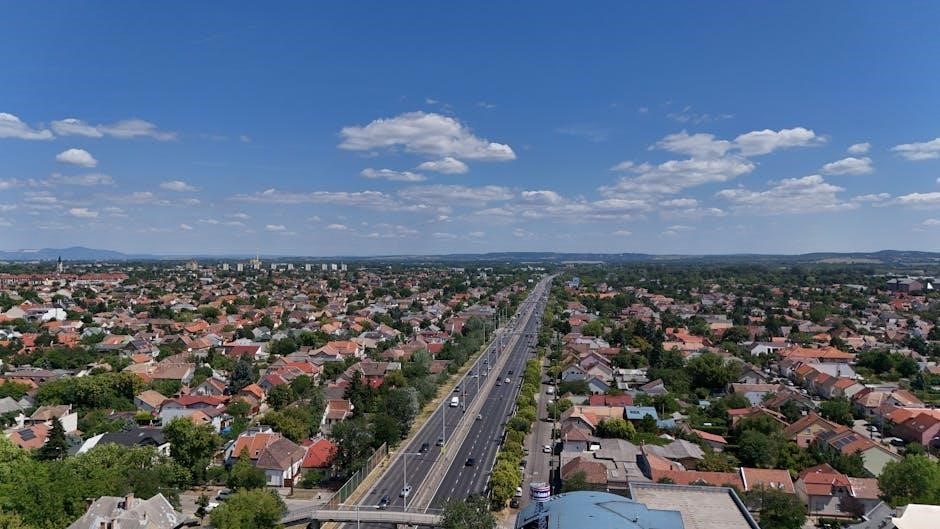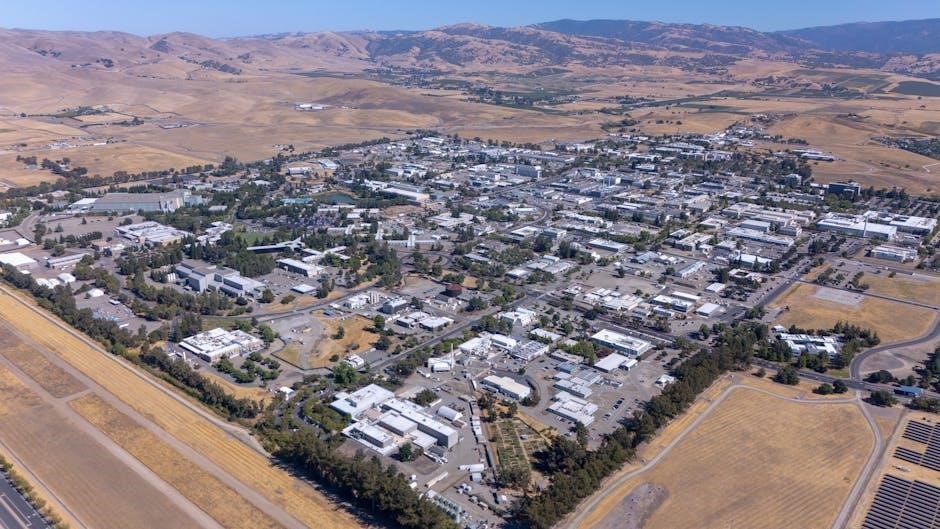Our Town by Thornton Wilder is a timeless play exploring life, love, and death in the fictional town of Grover’s Corners. This Pulitzer Prize-winning masterpiece, divided into three acts, examines the beauty of ordinary life and the significance of human connections. Available in PDF formats for study, it remains a cornerstone of American theater, offering profound insights into the universal human experience.
Overview of the Play
Our Town by Thornton Wilder is a poignant exploration of life, love, and death in the fictional town of Grover’s Corners. The play is divided into three acts: Daily Life, Love and Marriage, and Death and Eternity. Set in the early 1900s, it follows the Gibbs and Webb families through ordinary moments and profound events. The minimalist stage design and narrator, the Stage Manager, emphasize the universality of human experiences. The play’s themes of community, time, and mortality resonate deeply, making it a timeless classic of American theater.
Significance of the Title “Our Town”
The title Our Town reflects the play’s focus on the universal human experience through the lens of a small, fictional community, Grover’s Corners. It emphasizes the idea that the story of this town could be any town, making it relatable to audiences everywhere. The use of “our” creates a sense of intimacy and shared ownership, highlighting the collective nature of life and the interconnectedness of people. This title underscores the themes of community, simplicity, and the commonality of human existence, making it a powerful and enduring choice for the play.

Thornton Wilder and His Work
Thornton Wilder, a three-time Pulitzer Prize-winning author, explored themes of humanity and existence through his novels, plays, and essays. His work, including Our Town, reflects a deep understanding of universal human experiences, blending simplicity with profound insight into life, love, and mortality.
Biography of Thornton Wilder
Thornton Wilder, born on April 17, 1897, in Madison, Wisconsin, was a renowned American playwright, novelist, and essayist. He studied at Yale and Princeton, developing a passion for literature and drama. Wilder’s work often explored universal themes of humanity, earning him three Pulitzer Prizes. His most famous play, Our Town, debuted in 1938, cementing his legacy in American theater. Wilder passed away on December 7, 1975, leaving behind a body of work that continues to inspire and influence writers and audiences worldwide.
Major Themes in Wilder’s Works
Thornton Wilder’s works often explore the human condition, emphasizing simplicity, universal truths, and the interconnectedness of life. Themes of community, family, and individual identity are central, as seen in Our Town. Wilder also delves into the balance between tradition and progress, reflecting societal changes. His plays frequently address existential questions, encouraging audiences to appreciate the ordinary and find meaning in everyday moments. Through minimalist settings and profound dialogue, Wilder highlights the beauty of life’s simplicity and the shared experiences that unite humanity.
The Setting of “Our Town”
Our Town is set in Grover’s Corners, New Hampshire, between 1901 and 1913. The play captures the essence of small-town life, emphasizing simplicity and community bonds, while reflecting the gradual changes of the early 20th century.
Grover’s Corners: The Fictional Town
Grover’s Corners, the setting of Our Town, is a charming, fictional New Hampshire town. It embodies the quintessential American small-town experience, where everyone knows each other’s lives intimately. The town’s layout, with Main Street, the railway station, and Polish Town across the tracks, reflects its modest charm. Life in Grover’s Corners is simple, with routines like school, work, and family gatherings. However, subtle changes, such as the increasing use of automobiles, hint at the passage of time and modernization.

Historical Context of the Early 1900s
The early 1900s in Grover’s Corners reflect a transitional period in American life. The town, set in the early 20th century, showcases the shift from traditional ways to modernity. Horses gradually give way to automobiles, and farmers increasingly use Fords. The locking of house doors at night signals a growing formality in societal behavior. The era also highlights the integration of technology, such as telephones, into daily life. These subtle changes underscore the evolving nature of small-town America during this transformative time.

Key Characters in “Our Town”
The play centers around the Gibbs and Webb families, representing everyday life in Grover’s Corners. Doc Gibbs, Mrs. Gibbs, George, Emily, and Mr. Webb are central figures.
The Gibbs Family
The Gibbs family is a central focus in Our Town, embodying the essence of small-town life. Dr. Frank Gibbs, the town’s respected doctor, and his wife, Julia, are portrayed as pillars of the community. Their children, George and Rebecca, navigate the challenges of growing up, with George’s journey from adolescence to maturity being a key narrative thread. The family’s interactions highlight themes of family, tradition, and the passage of time, making them relatable and endearing to audiences.

The Webb Family

The Webb family, another central family in Our Town, reflects the quiet strength and traditional values of small-town life. Mrs. Webb, the matriarch, is a kind-hearted homemaker who manages the household with grace. Her daughter, Emily, is a bright and sensitive soul whose journey through life, love, and loss becomes a poignant focus of the play. The Webbs’ interactions with the Gibbs family highlight the deep connections within the community, emphasizing themes of family, friendship, and the enduring cycle of life, making their story both relatable and timeless.
Other Notable Characters
Beyond the Gibbs and Webb families, other notable characters enrich the tapestry of Grover’s Corners. The Stage Manager serves as the narrator, guiding the audience through the story while breaking the fourth wall. Simon Stimson, the town’s troubled choir director, adds depth with his tragic backstory. Rebecca Gibbs, the curious and thoughtful daughter of Doc Gibbs, brings youthful perspective. Howie Newsome, the friendly milkman, embodies the town’s warmth and routine. These characters, though not central, contribute to the play’s exploration of universal human experiences and small-town life.
Themes of “Our Town”
Our Town explores universal themes such as the importance of community, the cycle of life and death, and the passage of time, highlighting the beauty of ordinary life and the interconnectedness of human experiences.
The Importance of Community
Community is a cornerstone of Our Town, as the residents of Grover’s Corners share moments of daily life, support each other in times of need, and celebrate collective milestones. The play highlights how shared experiences and traditions strengthen bonds among neighbors, creating a sense of belonging. Through characters like the Webbs and Gibbs, Wilder illustrates the value of knowing and supporting one another, emphasizing that community is vital to a fulfilling life.
The Cycle of Life and Death
Our Town poignantly explores the cycle of life and death through its characters’ journeys. Emily Webb’s death in Act 3 profoundly illustrates the inevitability of mortality, while her brief return to life highlights the preciousness of everyday moments. Wilder’s portrayal of death as a natural part of existence encourages reflection on life’s meaning. The play’s timeless themes remind audiences to cherish the present and understand death as a universal experience that unites humanity, offering a deeper appreciation for the fleeting nature of life.
Thornton Wilder’s Our Town captures the relentless passage of time through its three-act structure. The play transitions seamlessly from the routine of daily life to the profound moments of love and death, illustrating how time shapes human experiences. The minimalist stage design emphasizes the universality of time’s passage, allowing audiences to reflect on their own lives. The characters’ journeys through time serve as a reminder to cherish each moment, as the play masterfully conveys the inevitability and beauty of life’s progression, making it a timeless commentary on human existence. Our Town is divided into three acts: Daily Life, Love and Marriage, and Death and Eternity. Each act explores a phase of existence, guided by a narrator, reflecting on the human experience and the passage of time through the lives of Grover’s Corners’ residents. Act 1 introduces life in Grover’s Corners through the everyday routines of its residents. The scene opens at dawn on May 7, 1901, with the Gibbs and Webb families starting their day. Doc Gibbs and Mrs. Gibbs are shown managing their household, while George Webb and his sister Rebecca prepare for school. The act highlights ordinary moments—breakfast, chores, and small talk—emphasizing the quiet beauty of mundane life. The stage narrator guides the audience, setting the tone for the play’s exploration of simplicity and community. The minimalist set design underscores the universality of the story. Act 2 centers on the wedding of George Gibbs and Emily Webb, marking a pivotal moment in their lives. The act explores themes of love, commitment, and the passage of time, as the townspeople gather to celebrate the union. The minimalist stage design emphasizes the emotional depth of the occasion, while the narrator reflects on the universal nature of marriage. This act highlights the beauty of human connection and the enduring significance of such moments in small-town life, resonating deeply with audiences. Act 3 of Our Town shifts to the cemetery, where Emily Gibbs, now deceased, reflects on life and death. The act explores themes of mortality, memory, and the afterlife, as Emily reunites with other townspeople who have passed away. The minimalist stage design emphasizes the timelessness of the setting, while the narrator underscores the universality of death. This final act encourages audiences to appreciate the beauty of life and the enduring connections that transcend time, leaving a profound emotional impact. Our Town premiered in 1938, winning the Pulitzer Prize and becoming a cornerstone of American theater. Its exploration of ordinary life resonated deeply with audiences during a transformative period in U.S. history, offering timeless reflections on community and existence. Our Town premiered at Henry Miller’s Theatre in New York on February 4, 1938, and later moved to the Morosco Theatre. The play was groundbreaking, featuring minimal scenery and a direct address to the audience. Critics initially found it unconventional, but its emotional depth and universality resonated with audiences. It won the Pulitzer Prize in 1938, cementing its status as an American classic. Today, the play remains widely performed, with revivals like the 2023 Broadway production at the Ethel Barrymore Theatre, ensuring its enduring legacy. Download the PDF to explore its timeless themes. Our Town revolutionized American theater with its minimalist stage design and narrative techniques, breaking from traditional realism. Its success inspired playwrights to experiment with form and storytelling. The play’s universal themes resonated broadly, making it a staple in American drama. Its influence is evident in works by later playwrights, and it remains a cornerstone of theatrical education. The play’s enduring popularity underscores its significance in shaping modern theater, ensuring its continued relevance and impact on audiences and artists alike. Download the PDF to explore its legacy. Our Town uses symbolism to convey deeper meanings, such as the stage manager representing time and the audience’s guide. Grover’s Corners symbolizes universal human experiences, while minimal props emphasize life’s simplicity and timelessness. Download the PDF to explore these elements further. Our Town is rich in symbolic elements that enhance its universal themes. The stage manager acts as a narrator and guide, symbolizing time and the audience’s connection to the story. Grover’s Corners itself represents the quintessential American town, embodying simplicity and community; The minimalist stage design, with few props, underscores the timelessness of the story and shifts focus to the characters’ emotional journeys. These symbols, as seen in the PDF version, highlight Wilder’s exploration of life’s deeper meanings. Thornton Wilder’s Our Town employs minimalist stage design to emphasize the play’s universal themes. The bare stage, devoid of elaborate scenery, focuses attention on the characters and their interactions. This simplicity mirrors the ordinary nature of life in Grover’s Corners, allowing the audience to connect with the story on a deeper level. The lack of props and detailed sets underscores the timelessness of the narrative, as seen in the PDF version, making the play’s themes resonate across generations. Our Town remains a timeless reflection of human experience, resonating through its exploration of life, death, and community. Its themes of connection and simplicity continue to captivate modern audiences, as seen in recent adaptations and performances. The play’s universal appeal, preserved in its PDF versions, ensures its relevance in today’s fast-paced world, offering a poignant reminder of life’s preciousness and the importance of human bonds. Our Town explores universal themes that transcend time, such as the beauty of everyday life, the importance of human connections, and the inevitability of death. These themes resonate deeply in today’s fast-paced, technology-driven world, reminding audiences to appreciate life’s simple moments. The play’s focus on community and individual stories continues to evoke empathy and reflection, making it a relevant and enduring work. Its availability in PDF formats ensures its accessibility for modern readers and performers, preserving its timeless appeal. Recent adaptations of Our Town continue to captivate audiences, with a notable Broadway revival at the Ethel Barrymore Theatre. The play’s minimalist design has been reimagined, blending traditional and modern elements. Performances often highlight the timelessness of its themes, drawing new generations to its universal story. The availability of PDF versions has also supported educational adaptations, allowing schools and theaters to produce the play with ease. Its enduring appeal ensures that Our Town remains a staple of American theater, resonating with contemporary audiences. Our Town is widely available in PDF format, offering easy access for readers. Study guides and educational resources provide deeper insights, aiding students and educators alike. Our Town is widely available in PDF format, offering convenient access for readers worldwide. Various editions, such as the 1991 and 1975 publications, can be downloaded from platforms like Google Drive and Internet Archive. These digital versions preserve the original text, making it easy for students, educators, and theater enthusiasts to explore Wilder’s masterpiece. The PDF format ensures that the play’s timeless themes and structure are accessible for study and appreciation. Various study guides and educational resources for Our Town are available online, offering in-depth analyses and teaching tools. These resources include summaries, character analyses, and thematic explorations, helping students and educators understand the play’s significance. Platforms like APT’s Study Guide provide contextual information, while educational websites offer downloadable materials. These resources enhance the learning experience, making Wilder’s masterpiece accessible and engaging for both academic and theatrical purposes. Our Town remains a timeless exploration of life, love, and mortality, resonating deeply with audiences. Its enduring themes and minimalist design ensure its relevance, making it a cherished classic in American theater; Our Town by Thornton Wilder has left an indelible mark on American theater; Since its 1938 debut, it has become a classic, celebrated for its universal themes of life, love, and death. The play’s minimalist stage design and profound storytelling have influenced countless productions. Its exploration of human connections continues to resonate with audiences, ensuring its enduring relevance. As a PDF, it remains accessible for study, preserving Wilder’s vision for future generations to appreciate and interpret anew. Our Town remains a profound exploration of human existence, emphasizing the beauty in everyday life and the inevitability of change. Its themes of community, love, and mortality transcend time, resonating with audiences globally. As a PDF, the play is widely accessible, ensuring its timeless message endures. Wilder’s masterpiece continues to inspire reflection on life’s simplicity and the importance of human connections, solidifying its place as a cornerstone of American literature and theater, forever relevant in understanding our shared human experience.The Passage of Time
Structure of the Play
Act 1: Daily Life
Act 2: Love and Marriage
Act 3: Death and Eternity


Historical and Cultural Context
Premiere and Reception of “Our Town”
Premiere and Reception of “Our Town”
Impact of the Play on American Theater

Symbolism in “Our Town”
Symbolic Elements in the Play
Use of Minimalist Stage Design

Modern Relevance of “Our Town”
Timeless Themes in the Modern World
Recent Adaptations and Performances
Resources for “Our Town”
PDF Versions of the Play
Study Guides and Educational Resources
Legacy of “Our Town”
Final Thoughts on the Play’s Significance
